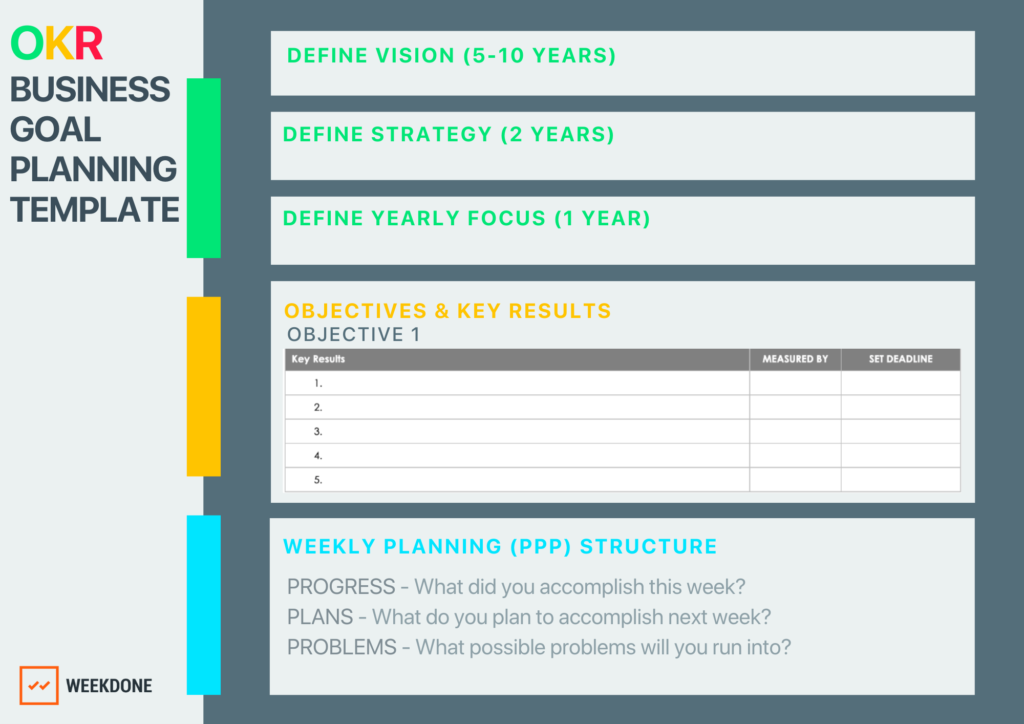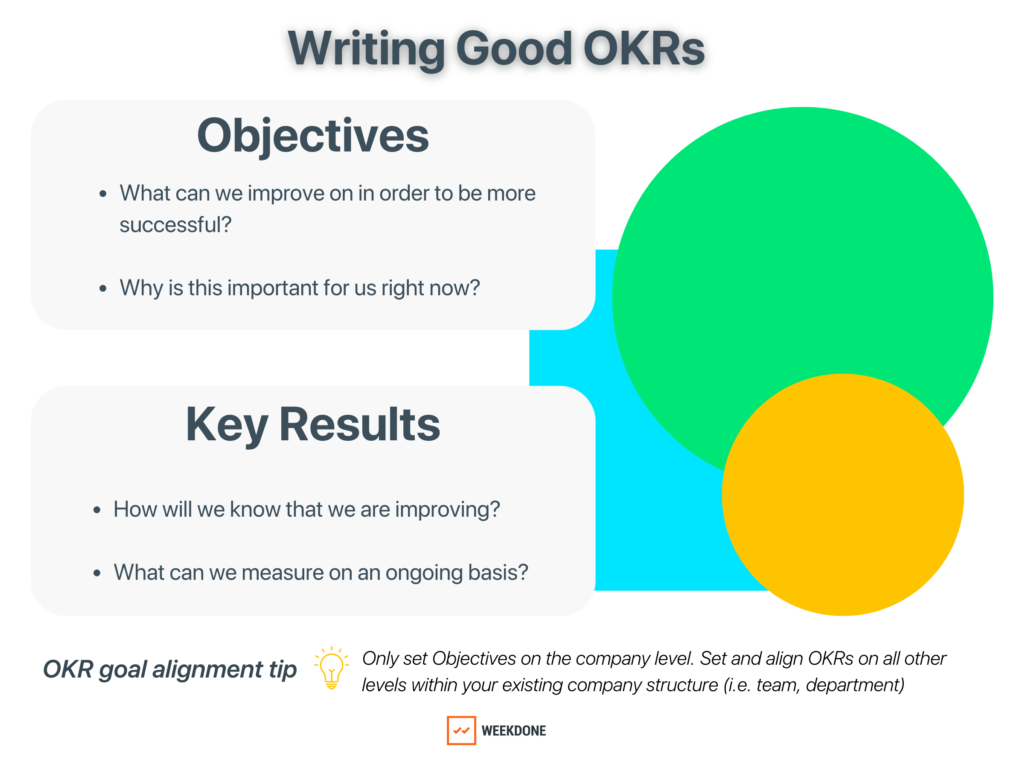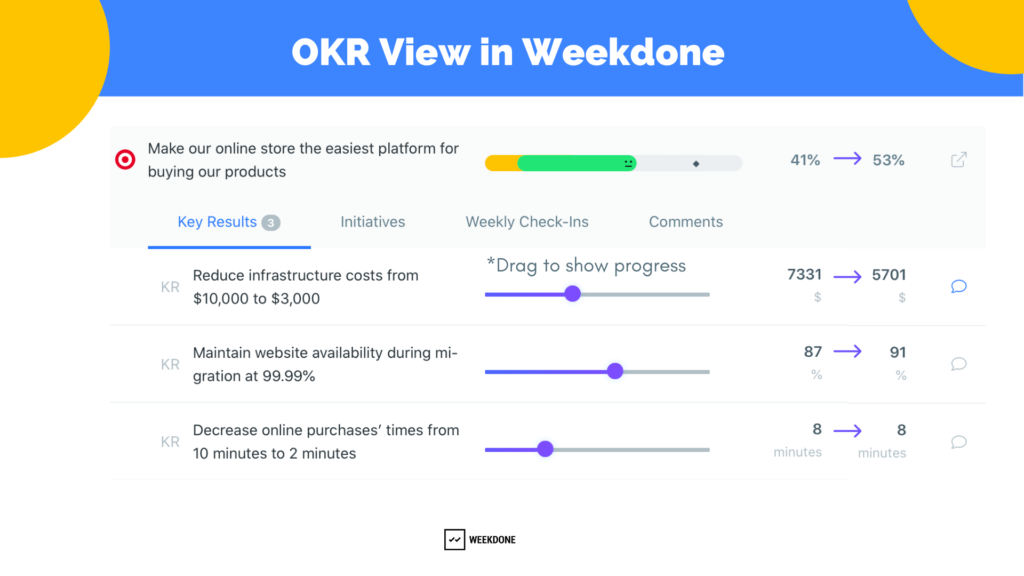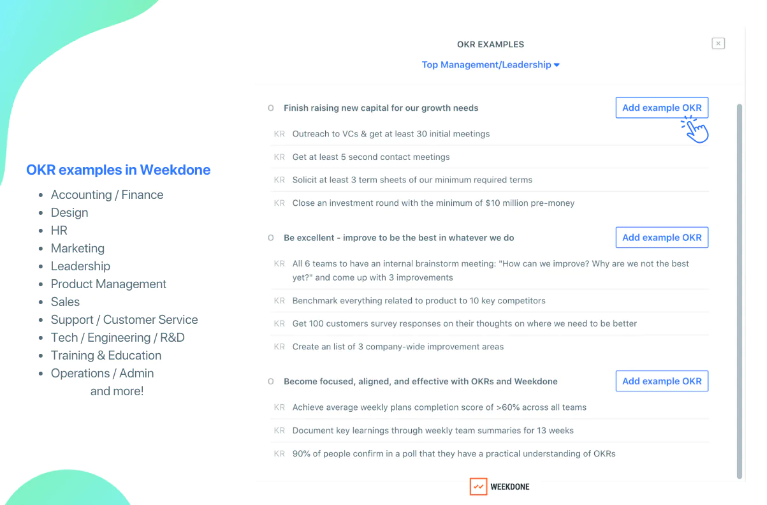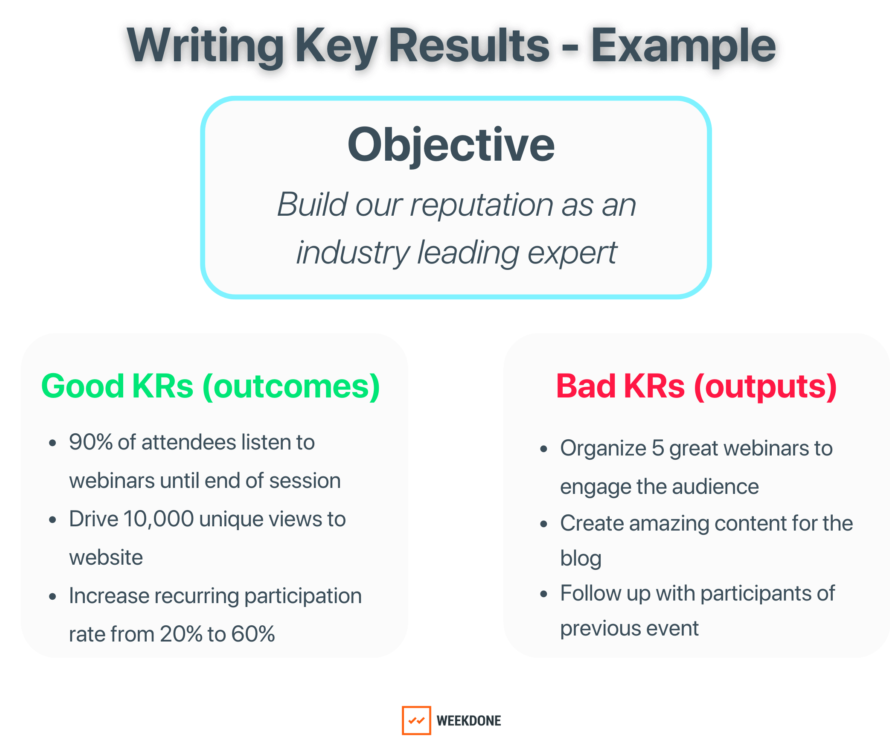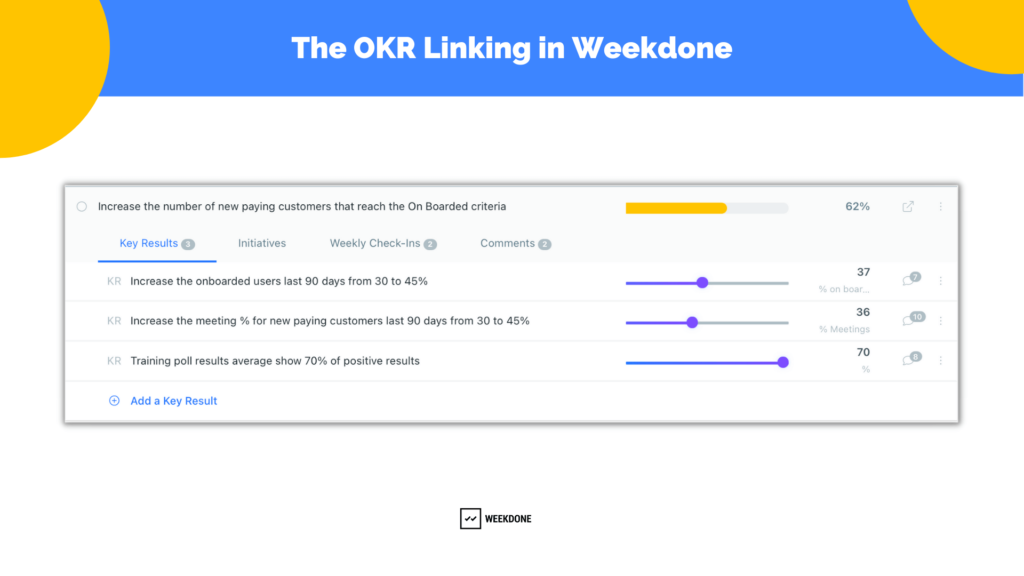Effective business leaders not only have a clear vision, they also know how to communicate it clearly and translate it into action plans. Understanding the company’s direction and knowing how individual contribution (output) is attributed to achieving overarching business objectives (outcomes) is the essence of creating a goal-setting and growth mindset.
“Good business leaders create a vision, articulate the vision, passionately own the vision, and relentlessly drive it to completion” – Jack Welch
For instance, your company’s goals or business objectives could be to:
- Generate $200K in revenue
- Increase customer retention by 25%
- Launch 5 new products
Considering only these high-level annual business goals without day-to-day/weekly/monthly action plans can lead to loss of focus and misalignment.
That’s why business goal-setting using an effective approach is important. The Objective and Key Results (OKR) framework is a proven methodology used by leading companies to achieve their business goals.
Try OKR Goal Setting Software
Keep business goals front and center with tracking functionalities and visual dashboards – stay focused, achieve real results.
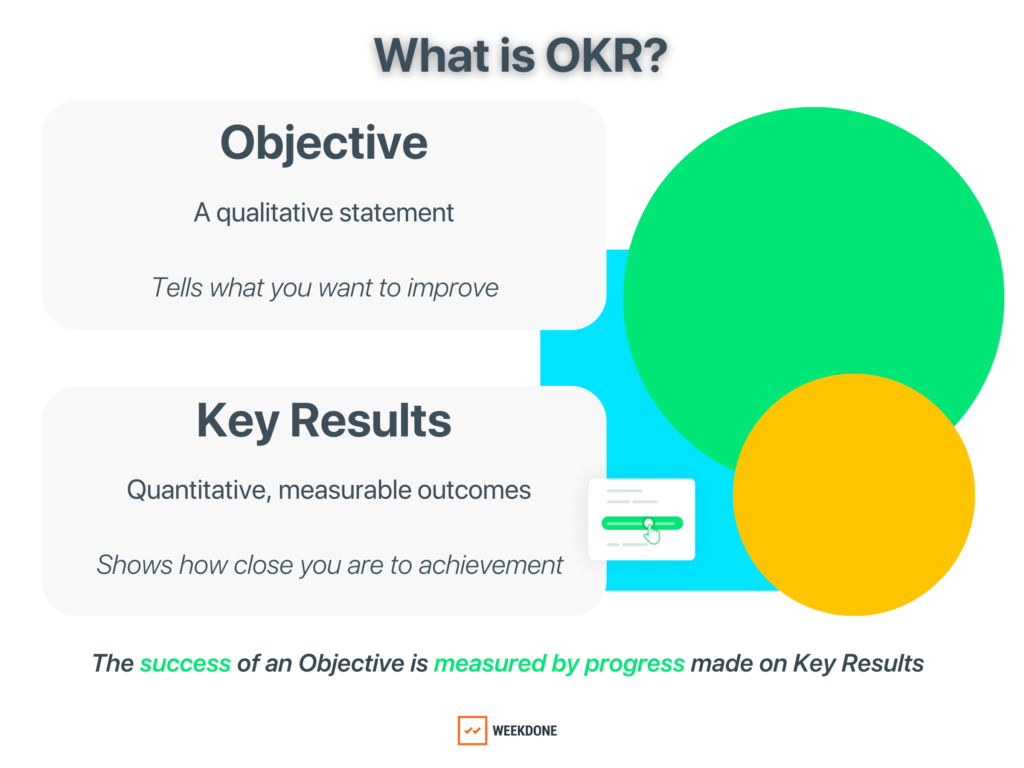
If you have created your business goals already, here is an effective way to track them and stay aligned.
Business Goals Template [Free Download]
Download your free business goals planning template here!
This simple, business goals template is easy to use and perfect for articulating your business goals in one place. It can be used by any type of business across industry sectors.
How to Use the Business Goals Template
1. Define Company Vision
This is the most important part of your goal-setting process. Your business vision is the foundation of your overall business.
The vision needs to be a brief and concrete mission statement. While you can redefine your vision annually, it ideally should stay consistent for at least 5-10 years.
Define success and visualize how your business would be when it’s most successful. For instance, your vision could be “to become the biggest company with the largest market share in your sector”, or “to become the #1 customer-centric company delivering the highest customer value”, or it could be to “become the company with the highest brand value”.
Typically your vision must be an aspirational statement that provides direction and focus for everyone in the company to keep in mind when creating their goals.
2. Define Strategy
A strategy is an important part of running a successful business. While you may have different strategies for different business functions, you must have one overall strategy for success.
When starting out, you can choose a strategy that is tried and tested for your business. In time, you can change to align them with new business goals that you aspire to reach. Think about your niche segment and how you can realistically gain a competitive position in the market within a specified period.
3. Define Annual Focus Areas
Record the most important focus areas for the year. This could be simple as “revenue” or “invest in public relations”.
Focus areas would be the “theme” of your fiscal year. What do you want to focus on in twelve months? Why do you want to focus on it? Does this focus result in you achieving your vision and strategy?
For instance, the focus area could be to “invest heavily in content marketing and link building” to achieve the 5-10 year vision to “have the biggest organic traffic in the software market.”
4. Set OKRs
The Objectives and Key Results (OKRs) section of the template is where quarterly planning happens. Define an Objective you want to achieve within 3 months and set Key Results that will help you track and measure progress made toward that Objective.
The OKR goal-setting methodology is popular among leading companies like Google. This goal system is a simple process to understand and is different from traditional planning methods in that it is constantly set, tracked, and evaluated.
💡 Keep in mind that you can learn how leading companies set their goals but you must tailor your OKR approach to fit your needs.
Use a Guided OKR-writing Tool
Write high quality OKRs from scratch with a built-in OKR Wizard and example OKRs. Keep goals front and center with color-coded tracking and visual dashboards.
In the business goals template provide we have listed three Objectives:
- Improve brand presence
- Improve content and distribution
- Achieve record metrics in blog organic traffic
For every Objective, make sure to list the Key Results you want to achieve (up to five per Objective) and the metrics to measure them. Also, include a reasonable deadline to achieve each Key Result.
For instance, for the Objective to “improve brand presence” a Key Result you may want to achieve could be to “earn five placements in mainstream media in the quarter”. You could measure this on a scale of 1 to 5. Revisit and evaluate Objectives and Key Results every quarter and revise them if it is not achieved.
Here’s a snapshot of an OKR example:
👉 Read more to learn how to write good OKRs and watch how to implement OKRs and to put theory to practice using a step-by-step OKR example.
5. Plan, Track and Review Weekly
The weekly planning (Plans, Progress, and Problems) process gives you an idea about the progress made toward achieving your goals.
Ideally conducted on a Friday it gives a snapshot of weekly performance. What did you accomplish in the week? What do you plan to accomplish next week? What problems do you expect? It is best to keep it concise and also include achievements no matter how small (such as publishing two blog posts).
6. Review Desired Outcomes
Revisit your desired outcome weekly and define the measurements for success for the next week. A simple example could be “Increase the number of new visitors to the blog by 35%”. Keeping these measurements brief and realistic works well.
Track Business Goals with OKRs
A dedicated OKR software with automated reminders, tracking features and visual dashboards can help you stay focused, aligned, and achieve outcomes.
5. Plan, Track and Review Weekly
The weekly planning (Plans, Progress, and Problems) structure should be visited once a week (we suggest Friday) to look at how different goals have been accomplished.
Look at how the week went. What did you accomplish this week? What do you plan on accomplishing next week? What problems do you expect to run into? Be brief here and don’t be afraid to include achievements that are relatively small, such as publishing two blog posts.
6. Desired Outcome
Like the above section, you’ll want to revisit your desired outcome each and every week on a Friday. Define the measurements for success for the next week. This can be as simple as having an agreed roadmap that your marketing team can use for writing content for the next few months. Keep these measurements brief and realistic.
“What are Business Goals Examples?”
Business goals can be either long term (1 + years) or short term (3 months or less).
Examples of short-term business goals:
- Increase the number of published blog posts per week from 3 to 5
- Create a marketing campaign for collecting clients’ reviews
- Increase traffic to the company’s template library
- Hire a new product marketing manager within the next month
Examples of long-term business goals:
- Increase Community Outreach
- Increase Market Share
- Increase the total income of your company by 30% over the next year
- Reduce production expenses by 10% over the next three months
- Grow Shareholder Value
- Increase overall brand awareness
- Develop and launch three new products.
📚 Searching for more examples? Here are 40 + business goals examples to get you started and learn different goal setting frameworks you can adopt.
Spreadsheets Vs OKR Software: Implement Goal Effectively
Setting goals may be easy, but aligning them and tracking progress can be challenging. That’s why using spreadsheets to track goals and OKRs are not suitable. Instead, to implement the OKR framework accurately, using a dedicated software platform delivers better results.
Why Spreadsheets are Less Effective
Here are some of the reasons spreadsheets are not a feasible option compared to software applications for implementing OKRs:
- Spreadsheets enable only recording of goals and do not provide an efficient way to track and align them
- The process of recording and updating progress of company goals can be time-consuming and
- The manual process of updating goals could lead to errors and does not provide the agility to make changes
- A static record of goals does not encourage engagement and making the team aware of regular updates can be tedious
- Compliance and participation in goal setting can be difficult to achieve
- It can get difficult to use spreadsheets when cascading OKRs
- Alignment and ensuring dependencies are connected could be challenging to maintain
- Tracking goals of multiple teams and projects in multiple spreadsheets can be unfeasible
Why a Dedicated OKR Software Works for Implementing Goals
- View and track business objectives and key results of all teams and the company in one place
- Get visibility into team-level and company goals and ensure alignment
- Encourage engagement with reminders to update metrics of key results
- Monitor the progress of goals effectively using reporting dashboards
- Get an overview of overall progress in an instant to make improvements with agility
- Streamline workflows and ensure meetings more constructive with effective tracking and reporting features
How to Set Business Goals Using a Dedicated OKR Software
It can be difficult to set and maintain company goals in spreadsheets. To make goal setting a collaborative process using a dedicated OKR software is an ideal option. Setting your company goals using a platform can add more value to tracking business goals.
Here’s a simple process to set OKRs in a software application:
- Begin with the Company Objective. Objectives on the Company level represent high-level aspirational goals.
- Set team level OKRs. Team Objectives are improvement goals aligned with the overarching goals and must be linked to the Company Objective. They technically translate to Company level Key Results.
- Add Key Results. Each Team Objective must ideally have between 3-5 Key Results which are measurable outcomes that represent a valuable change in the business. Key Results can be measured on a scale of 0-100% or any numerical unit (for example, $, %, items, clients, etc.).
- Ensure to leave comments every time you update progress on a KR. This provides helpful insights and records lessons learned.
Get Organized and Take Goal-Setting to The Next Level
Using a business goals template is a good way to organize company goals and start the next quarter with specific milestones. This business goal-setting worksheet helps to collaboratively set and track OKRs as a team. Here are some resources that could help you use the business goals template more effectively:
- OKR examples for different teams – to transform ideas to action
- Should you use a spreadsheet or goal-setting software?
- How to stay on course with OKR Tracking Best Practices
- What are some of the good and bad OKR examples and how to set OKRs?
- How to align OKRs at every level of the company?
Ready to set your business goals and automate the goal tracking process using a dedicated OKR software?
